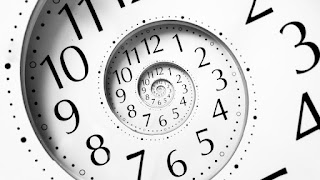It's about time
Time is essential in Hamiltonian mechanics which is the natural way to transition from classical to quantum mechanics. Usually one is introduced to the subject by the naive statement that we replace the Poisson bracket with the commutator. The story is much more subtle (and interesting) than that and today I want to explore only some parts of those issues with the remaining advanced topics to be discussed at a later time.
It turns out that there is a circularity problem: time is derived from quantum mechanics and quantum mechanics is derived from time. Let me state upfront that I do not yet know how to solve this very interesting and hard problem.
Today I'll present the claim that time has a quantum mechanical origin. The main proponents of this are Alain Connes and Carlo Rovelli in their Thermal Time Hypothesis. I have talked about this last year, but now I want to go in depth in the mathematical reasoning. As a pre-requisite the reader should understand the concept of short exact sequences and I have a review of this topic here.
I am not attempting to justify the canonical gravity point of view and oppose it to string theory, but I want to present the mathematical reasons of why time may have a non-commutative (quantum mechanical) origin. The mathematical underpinnings are von Neumann algebras and the Tomita-Takesaki theory.
The von Neumann algebras are the generalization of measure theory: they reduce to the study of measureable spaces when we restrict to the commutative case.
Suppose \(M\) is a von Neumann algebra in a Hilbert space H, \(a\) is an element of \(M\), and we have an operator S defined by:
\(S a \psi = a^* \psi\)
Then S admits a polar decomposition:
\(S = J \Delta^{1/2}\)
with \(\Delta\) a positive self-adjoined operator and J anti-unitary.
The Tomita-Takesaki theory proves that:
\(JMJ = M^{'}\): M has the same size as its commutant
\(\Delta^{-it} M \Delta^{it} = M\): there is an one-parameter group of automorphism \(\sigma^\phi_t\) which gives the time flow in the Heisenberg picture.
So far so good, but stronger statements can be made. If we impose the KMS condition, then the automorphism is unique. Still, it depends on the choice of the state \(\phi\). The really powerful result is that in the exact sequence:
\(1\rightarrow Inn(M) \rightarrow Aut(M) \rightarrow Out(M) \rightarrow 1\)
where \(Inn(M)\) is the normal subgroup of inner automorphisms: \(T\rightarrow aTa^*\), the automorphism \(\sigma^\phi_t\) does not depend upon the choice of state \(\phi\) and hence it is a canonical time evolution.
This is the main mathematical result (by Connes) which needs to be applied to physics to understand what is going on. And this is what Connes and Rovelly do in their thermal time hypothesis paper. But there is more to the story. The short exact sequence from above was the starting point of Connes non-commutative geometry description of the Standard Model which led to the geometric unification of gauge theory weakly coupled with gravity in the non-commutative framework (no quantum gravity here: no background independence arguments to justify loop quantum gravity vs. string theory). In the simplest model of the noncommutative description of the \(SU(n)\) gauge group weakly coupled with non-quantized gravity, the short exact sequence from above is equivalent with:
\( 1 \rightarrow \mathcal{G} = Map(M, SU(n)) \rightarrow Diff(X) \rightarrow Diff(M) \rightarrow 1\)
\(1\rightarrow fiber\rightarrow total space\rightarrow base\rightarrow 1\)
where M here is a spin Riemannian manifold. The full group of invariance on a new space \( X = M \times M_n (C) \) is the semidirect product of the diffeomorphisms on M with the gauge group. The diffeomorphism shuffles (acts on) the group of gauge transformations.
If we take the main lesson of quantum mechanics to be that of non-commutativity of operators, we can construct a generalization of commutative mathematics into a non-commutative domain:
Commutative
|
Noncommutative
|
measure space
|
von Neumann algebra
|
locally compact space
|
C∗- algebra
|
vector bundle
|
finite projective module
|
complex variable
|
operator on a Hilbert space
|
real variable
|
sefadjoint operator infinitesimal compact operator
|
range of a function
|
spectrum of an operator
|
K-theory
|
K-theory
|
vector field
|
derivation
|
integral
|
trace
|
closed de Rham current
|
cyclic cocycle
|
de Rham complex
|
Hochschild homology
|
de Rham cohomology
|
cyclic homology
|
Chern character
|
Chern-Connes character
|
Chern-Weil theory
|
noncommutative Chern-Weil theory
|
elliptic operator
|
K-cycle
|
spin Riemannian manifold
|
spectral triple
|
index theorem
|
local index formula
|
group, Lie algebra
|
Hopf algebra, quantum group
|
Symmetry
|
action of Hopf algebra
|
In the non-commutative domain (quantum mechanics) one encounters a universal definition of a time flow which has no counterpart in commutative mathematics (or classical physics). In this sense time is a mathematical necessity of quantum mechanics arising out of operator non-commutativity.
But the implication works in the other way too. Starting with the necessity of time, we can consider infinitesimal time evolution and extract the Leibniz identity. And in the categorical approach or quantum mechanics reconstruction the Leibniz identity is the main starting point.
Next time I'll expand on this and the implication for the measurement problem.

No comments:
Post a Comment